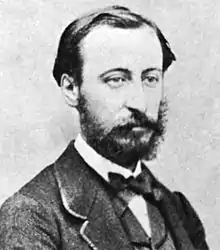Piano Concerto No. 1 (Saint-Saëns)
The Piano Concerto No. 1 in D major, Op. 17, by Camille Saint-Saëns was composed in 1858, when the composer was 23 and dedicated to Marie Jaëll. It is the first piano concerto ever written by a major French composer.

Saint-Saëns
Movements
There are three movements:
- Andante - Allegro assai- The piano concerto opens with a Wagnerian horn solo that fades to light strings, a soft piano melody, and more strings before breaking into the main theme of the piece. The horn is prevalent throughout, as are the strings, before concluding in D Major.
- Andante sostenuto quasi adagio- The second movement is very dark and falls slightly short of eerie; low, slow cellos back-dropped by plucking violins lead to a soft and slow piano melody. Meanwhile, the strings play a large part in the piece while the theme from the opening movement continues.
- Allegro con fuoco- A thunderous finale mixes all of the themes from the horns, the piano and the strings in a uplifting and inspiring and blazing finale, ending in the key of D Major.
Instrumentation
The work is scored for solo piano, 2 flutes, 2 oboes, 2 clarinets, 2 bassoons, 4 horns, 2 trumpets, timpani and strings. A notable feature is an opening triadic solo for the natural horn which predates the much more famous example of Johannes Brahms's B-flat Concerto by around 20 years.
Recordings
- Jeanne-Marie Darré, piano, Orchestre National de la Radiodiffusion Française, conducted by Louis Fourestier. 2 CD EMI 1955 1957 report 1996
- Aldo Ciccolini, piano, Orchestre de Paris, conducted by Serge Baudo. 2 CD Emi 1971. Choc de Classica 2019
- Philippe Entremont, piano, Orchestre du Capitole de Toulouse, conducted by Michel Plasson, 2 CD CBS Sony 1976
- Jean-Philippe Collard, piano, Royal Philharmonic Orchestra, conducted by André Previn (2 CD EMI classics 1987).
- Pascal Rogé, piano, Philharmonia Orchestra, conducted by Charles Dutoit. 2 CD Decca 1981
- Stephen Hough, piano, City of Birmingham Symphony Orchestra, conducted by Sakari Oramo. 2 CD Hyperion 2001. Gramophone Awards record of the year 2002. Diapason d'or, Choc Le Monde la Musique
- Anna Malikova, piano, Orchestre Symphonique de la WDR de Cologne, conducted by Thomas Sanderling. 2 SACD Audite 2010
This article is issued from Wikipedia. The text is licensed under Creative Commons - Attribution - Sharealike. Additional terms may apply for the media files.


